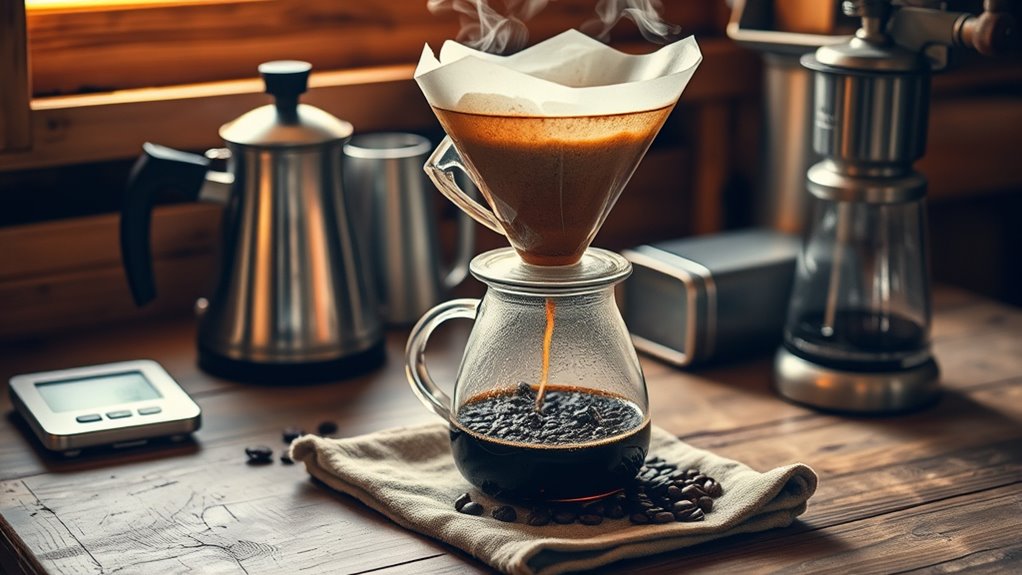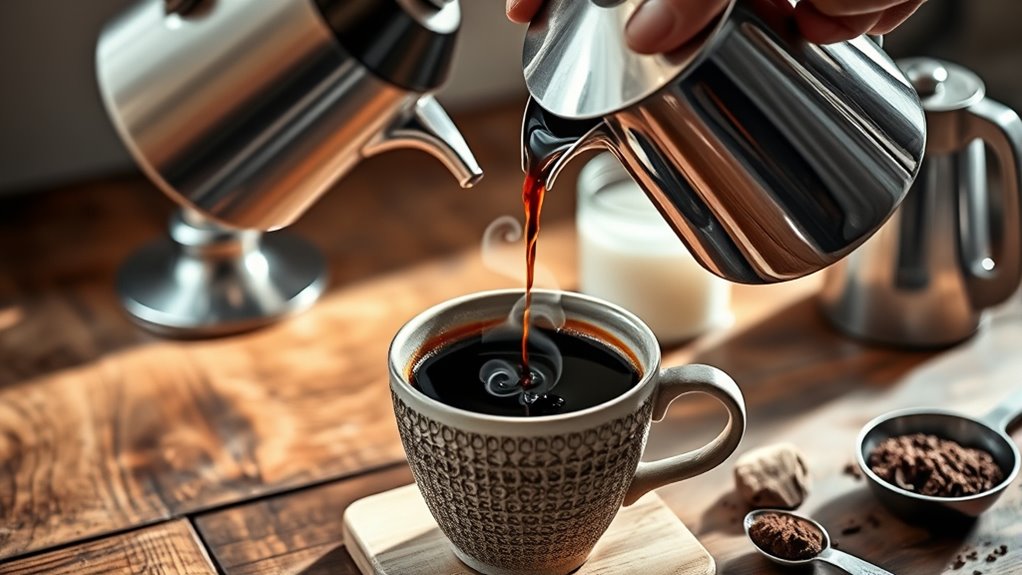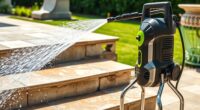To brew café-quality coffee at home, start with fresh, high-quality beans from reputable sources, and grind them just before brewing. Match your grind size to your method—coarse for French press, medium for drip, or fine for espresso. Use clean, filtered water heated to about 200°F and control brewing time carefully. Paying attention to these details boosts flavor and complexity. Keep experimenting with variables to perfect your craft—more tips await as you explore further.
Key Takeaways
- Select high-quality, freshly roasted beans and grind just before brewing for maximum flavor freshness.
- Match grind size to your brewing method, such as coarse for French press or fine for espresso.
- Use water just off the boil (~200°F) and control steep or brew times for optimal extraction.
- Employ precise pouring techniques, like bloom and slow, even pours, especially in pour-over brewing.
- Filter water and fine-tune variables like grind size and brewing time to achieve café-quality taste at home.

Ever wondered how to brew coffee that rivals your favorite café? It all starts with coffee bean selection. Choosing the right beans sets the foundation for a great cup. You’ll want to look for high-quality, freshly roasted beans. Opt for beans from reputable roasters or specialty coffee shops. Consider the flavor profiles you enjoy—whether it’s bright and fruity, deep and chocolaty, or nutty and smooth. Freshness is key; beans should be used within a few weeks of roasting for ideal flavor. Grind them just before brewing to preserve their aromatic oils and complex flavors. The grind size should match your brewing method—coarse for French press, medium for drip, fine for espresso—to ensure proper extraction.
Start with fresh, high-quality beans suited to your preferred brewing method for the perfect cup.
Once you’ve selected your beans, it’s time to master your brewing techniques. The right technique can elevate your coffee from good to exceptional. If you prefer a clean, bright cup, try pour-over brewing. Use a gooseneck kettle to control your pour, starting with a bloom to release carbon dioxide, then slowly pouring in circles to saturate all the grounds evenly. For a rich, full-bodied brew, French press is a great choice. Add coarsely ground coffee, pour hot water over it, and let it steep for about four minutes before pressing. The immersion process extracts more oils, giving your coffee a robust flavor. If you’re into convenience but still want quality, an Aeropress offers versatility and quick results. It allows you to experiment with brew times and pressures to find your perfect balance.
Temperature plays a crucial role as well. Aim for water just off the boil, around 200°F (93°C). Too hot, and you risk extracting bitter compounds; too cold, and you’ll end up with under-extracted, sour-tasting coffee. Use a thermometer or a kettle with temperature control to dial in the right heat. Timing is equally important—over-extraction leads to bitterness, while under-extraction results in weak flavor. Keep a timer handy and stick to recommended steep times for your chosen method. Additionally, understanding coffee extraction can help you fine-tune your brewing process for optimal flavor.
Finally, paying attention to your water quality can make a noticeable difference. Filtered water with balanced mineral content enhances the clarity and flavor of your brew. Experiment with different beans, grind sizes, and brewing times until you find your perfect combination. With a little practice and attention to detail, you can craft café-quality coffee right in your kitchen. The more you learn about coffee bean selection and brewing techniques, the more satisfying each cup becomes.
Frequently Asked Questions
What Are the Best Coffee Beans for Home Brewing?
When choosing the best coffee beans for home brewing, consider your flavor preferences. Single origin beans often provide unique flavor profiles that can elevate your cup. If you enjoy bright, fruity notes, look for beans from Ethiopia or Kenya. For richer, chocolatey flavors, try beans from South America. Experimenting with different single origin beans allows you to discover the perfect flavor profile that suits your taste buds and makes your coffee experience special.
How Do I Store Coffee Beans to Maintain Freshness?
Think of your coffee beans as delicate flowers needing a cozy, protected garden. To preserve their freshness, store them in an airtight container away from light, heat, and moisture—much like shielding those flowers from harsh weather. Keep your coffee storage in a cool, dark spot, like a cellar, to maintain flavor. This simple step guarantees your beans stay vibrant, so every brew remains fresh and full of flavor.
What Equipment Is Essential for Professional-Quality Coffee at Home?
To make professional-quality coffee at home, you need essential equipment like a good coffee grinder and water filtration system. Your grinder should have burrs for consistent grind size, ensuring ideal extraction. A water filter removes impurities, enhancing flavor clarity. Invest in a reliable kettle for precise pouring and a quality espresso machine or filter brewer. These tools help you craft café-quality coffee every time, right in your own kitchen.
How Can I Adjust Brewing Methods for Different Coffee Flavors?
To adjust brewing methods for different coffee flavors, focus on water temperature and brew time. For brighter, acidic notes, use slightly lower temperatures and shorter brew times. For fuller, richer flavors, increase the temperature and extend the brew time. Experiment with these variables to discover your preferred flavor profile, and keep notes to refine your technique for consistent, café-quality results at home.
What Are Common Mistakes to Avoid When Making Coffee at Home?
Imagine a dance where missteps cause the rhythm to falter. You should avoid grinding inconsistencies that lead to uneven extraction, which can dull your coffee’s flavor. Steer clear of over-extraction pitfalls by not brewing too long or using too hot water. Always measure your coffee and water precisely, and keep your equipment clean. These small adjustments help you craft a perfectly balanced cup every time, preventing common mistakes.
Conclusion
Now that you’ve learned the secrets to brewing café-quality coffee at home, you’re all set to impress yourself and others. Remember, practice makes perfect, so don’t be discouraged if your first few attempts aren’t flawless. Keep experimenting and refining your technique, because the more you learn, the better your coffee will taste. Before you know it, you’ll be turning every morning into a special occasion—proof that patience and persistence truly pay off.









